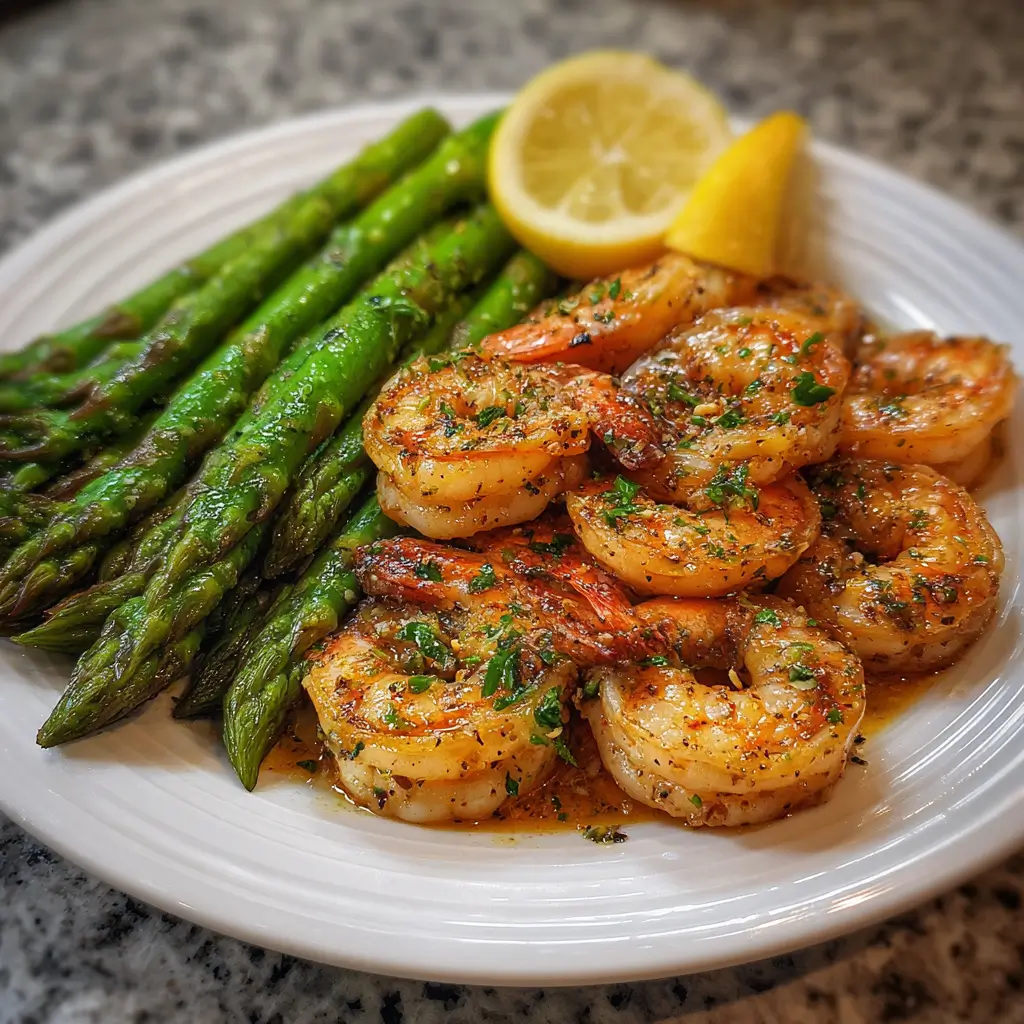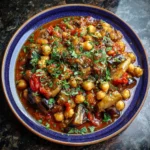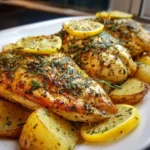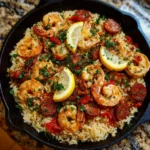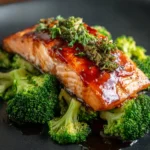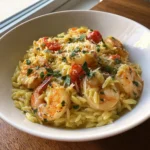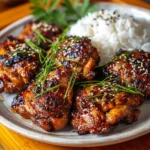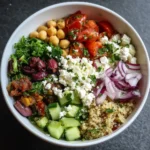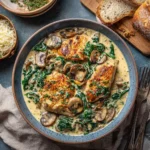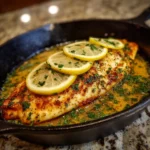Garlic Butter Shrimp and Asparagus: A Gourmet One-Pan Delight
The History
The origins of Garlic Butter Shrimp and Asparagus trace back to the rich culinary traditions of coastal Mediterranean and French cuisines, where fresh seafood meets vibrant vegetables in simple yet flavorful preparations. While shrimp cooked in garlic butter has long been a staple in dishes like Ecrevisse à la Nantua or Italian Gamberi al Burro e Aglio, the pairing with asparagus adds a modern twist influenced by American farm-to-table trends. This dish reflects the evolution of global fusion cooking—honoring traditional techniques while embracing seasonal produce and efficient, one-pan meals popularized in 21st-century home kitchens. Its rise in popularity can also be credited to social media food culture, where visually appealing, quick-prep recipes dominate feeds and inspire home chefs worldwide.
Ingredients Breakdown
Every component in Garlic Butter Shrimp and Asparagus plays a vital role in building layers of flavor, texture, and nutrition:
- Shrimp (large, peeled and deveined): The star protein—succulent, low in fat, and rich in selenium and iodine. Opt for wild-caught or sustainably farmed shrimp for best quality.
- Fresh asparagus: Adds earthy sweetness and crisp-tender texture. Look for firm stalks with tightly closed tips; thicker spears hold up better during sautéing.
- Unsalted butter: Provides a rich, creamy base that carries the flavors of garlic and herbs. Using unsalted allows control over sodium levels.
- Garlic (freshly minced): Offers pungent aroma and depth. Fresh is essential—avoid jarred minced garlic for superior taste.
- Olive oil: Prevents butter from burning and adds a fruity complexity when combined with butter.
- Lemon juice (freshly squeezed): Brightens the dish with acidity, balancing the richness of butter and enhancing shrimp’s natural sweetness.
- Red pepper flakes: Introduce gentle heat that contrasts beautifully with the buttery sauce.
- Salt and freshly ground black pepper: Fundamental seasonings that enhance all other ingredients.
- Fresh parsley (chopped): Adds a pop of color and herbal freshness at the end.
- Dry white wine (optional): Deglazes the pan, adding acidity and complexity to the sauce—choose a crisp variety like Sauvignon Blanc or Pinot Grigio.
- Grated Parmesan cheese (optional): For an umami boost and creamy finish, especially when serving over pasta or grains.
Step-by-Step Recipe
- Prep the Ingredients: Pat the shrimp dry with paper towels to ensure proper searing. Peel and mince the garlic. Trim the woody ends off the asparagus by snapping them where they naturally break. Chop fresh parsley and set aside.
- Heat the Pan: Place a large skillet or sauté pan over medium-high heat. Add a combination of olive oil and half the butter (about 1 tbsp each) to prevent burning while maximizing flavor.
- Sear the Shrimp: Once the butter melts and begins to sizzle, add the shrimp in a single layer. Cook for 1–2 minutes per side until pink and slightly golden. Remove and set aside on a plate—do not overcook at this stage.
- Sauté the Asparagus: In the same pan, add the asparagus spears. Toss to coat in the residual butter and oil. Cook for 5–6 minutes, stirring occasionally, until bright green and tender-crisp. Lower heat if browning too quickly.
- Add Garlic and Seasonings: Reduce heat to medium. Add the remaining butter, minced garlic, red pepper flakes, salt, and black pepper. Stir constantly for about 30 seconds to release the garlic’s aroma without burning it.
- Optional Wine Deglaze: Pour in ¼ cup of white wine, scraping up any browned bits from the bottom of the pan. Let it simmer and reduce by half, about 2 minutes.
- Return Shrimp to Pan: Add the cooked shrimp back into the skillet with the asparagus. Toss gently to reheat and coat everything in the fragrant garlic butter sauce.
- Finish with Lemon and Herbs: Squeeze in fresh lemon juice and sprinkle chopped parsley. Stir briefly to combine—about 30 seconds more.
- Serve Immediately: Plate hot, garnishing with extra parsley, lemon wedges, and optional Parmesan if desired.
Tips
- Don’t Overcook the Shrimp: Shrimp cook quickly and become rubbery if left too long. Remove them from the pan as soon as they turn opaque and pink.
- Use Cold Butter When Adding Back: To emulsify the sauce smoothly, consider adding cold butter cubes at the end for a silky, restaurant-quality finish.
- Prep Everything Ahead: Mise en place is crucial. Since the cooking process moves fast, having all ingredients prepped ensures nothing burns while you chop.
- Adjust Heat Wisely: Garlic burns easily. If using high heat for searing, reduce it before adding garlic to avoid bitterness.
- Season in Stages: Lightly season shrimp before cooking, then adjust final seasoning after combining all elements for balanced flavor.
- Let Asparagus Roast, Not Steam: Avoid overcrowding the pan. If needed, cook asparagus in batches to ensure even browning.
- Reserve Pasta Water (if serving over pasta): The starchy liquid helps bind the sauce to noodles for a cohesive dish.
Variations and Customizations
Garlic Butter Shrimp and Asparagus is incredibly versatile. Here are some creative ways to customize it:
- Creamy Version: Stir in 2–3 tablespoons of heavy cream or crème fraîche at the end for a luscious, velvety sauce.
- Spicy Kick: Add sliced jalapeños or increase red pepper flakes. A dash of smoked paprika enhances warmth without overwhelming heat.
- Herb Variations: Swap parsley for dill, tarragon, or chives for different aromatic profiles—dill pairs especially well with lemon and shrimp.
- Add Mushrooms: Sauté sliced cremini or shiitake mushrooms with the asparagus for earthy depth.
- Citrus Twist: Use orange or lime juice instead of lemon, or add zest for a fragrant citrus lift.
- Protein Swap: Replace shrimp with scallops, chicken breast strips, or even tofu for a vegetarian option.
- Grain Bowl Style: Serve over quinoa, farro, or brown rice with cherry tomatoes and avocado for a hearty bowl.
- Pasta Integration: Toss with linguine, fettuccine, or orzo. Reserve pasta water to help the sauce cling better.
- Baked Option: Arrange shrimp and asparagus on a sheet pan, drizzle with garlic butter, and roast at 400°F (200°C) for 12–15 minutes.
- Dairy-Free/Vegan: Use plant-based butter and omit cheese. Add nutritional yeast for a cheesy note.
Health Considerations and Nutritional Value
This dish balances indulgence with nutrient-dense ingredients, making it suitable for various dietary preferences when adjusted appropriately.
- Shrimp: Low in calories and high in protein (about 20g per 3 oz), shrimp provides omega-3 fatty acids, vitamin B12, phosphorus, and antioxidants like astaxanthin, which supports skin and eye health.
- Asparagus: Packed with fiber, folate, vitamins A, C, E, and K, and glutathione—a powerful antioxidant. It also acts as a natural diuretic, aiding digestion and reducing bloating.
- Butter and Olive Oil: While high in fats, they primarily contain heart-healthy monounsaturated fats (especially olive oil). Moderation is key; using a mix balances flavor and nutrition.
- Garlic: Known for its anti-inflammatory and immune-boosting properties due to allicin content. May support cardiovascular health and lower blood pressure.
- Lemon Juice: Rich in vitamin C, aids iron absorption, and promotes detoxification through liver support.
Nutritional Estimate (per serving, serves 4):
| Nutrient | Amount |
|---|---|
| Calories | ~320 kcal |
| Protein | 25g |
| Total Fat | 20g |
| Saturated Fat | 8g |
| Carbohydrates | 8g |
| Fiber | 3g |
| Sugar | 3g |
| Sodium | 500mg (adjustable) |
| Vitamin A | 20% DV |
| Vitamin C | 35% DV |
| Folate | 30% DV |
| Iron | 10% DV |
Dietary Notes: Naturally gluten-free, low-carb, and keto-friendly. Can be adapted for dairy-free and paleo diets with substitutions.
Ingredients
- 1.5 lbs (680g) large shrimp, peeled and deveined
- 1 bunch fresh asparagus (about 1 lb / 450g), trimmed
- 4 tbsp unsalted butter, divided
- 2 tbsp olive oil
- 5–6 cloves garlic, minced
- ½ tsp red pepper flakes (adjust to taste)
- ½ lemon, juiced (about 2 tbsp)
- Salt and freshly ground black pepper, to taste
- ¼ cup dry white wine (optional)
- ¼ cup fresh parsley, finely chopped
- Lemon wedges, for serving
- 2 tbsp grated Parmesan cheese (optional)
Directions
- Pat the shrimp dry with paper towels and season lightly with salt and pepper.
- In a large skillet over medium-high heat, warm 1 tablespoon olive oil and 1 tablespoon butter until shimmering.
- Add shrimp in a single layer and cook 1–2 minutes per side until just pink and opaque. Transfer to a plate.
- Add asparagus to the same pan. Sauté for 5–6 minutes until bright green and tender-crisp.
- Reduce heat to medium. Add remaining 3 tablespoons butter, garlic, and red pepper flakes. Stir 30 seconds until fragrant.
- If using wine, pour it in and simmer 1–2 minutes until reduced by half, scraping up browned bits.
- Return shrimp to the pan along with any accumulated juices. Toss to coat and heat through, about 1 minute.
- Stir in lemon juice and chopped parsley. Adjust seasoning with salt and pepper.
- Remove from heat. Serve immediately with lemon wedges and optional Parmesan.
FAQ
- Can I use frozen shrimp?
- Yes, but thaw them properly in the refrigerator overnight. Never cook frozen shrimp directly—it leads to uneven texture and excess moisture.
- How do I prevent rubbery shrimp?
- Avoid overcooking. Shrimp are done when they turn opaque and form a loose “C” shape. An overcooked shrimp curls tightly and becomes tough.
- Is this dish healthy?
- Yes! It’s high in protein, low in carbs, and features heart-healthy fats and antioxidant-rich vegetables. Control portion size and butter usage for optimal balance.
- Can I make it ahead of time?
- Best served fresh. However, you can prep ingredients (peel shrimp, trim asparagus, mince garlic) up to a day ahead and store separately in the fridge.
- What sides go well with this dish?
- Crusty bread, mashed potatoes, risotto, or a light arugula salad. For low-carb options, try cauliflower rice or zucchini noodles.
- Can I use margarine instead of butter?
- Not recommended. Margarine often contains water and additives that affect flavor and texture. Use real butter or a high-quality plant-based alternative if needed.
- Why did my sauce separate?
- This can happen if the heat is too high or the sauce isn’t emulsified properly. Remove from heat, swirl in a small piece of cold butter, or blend briefly with an immersion blender for smoothness.
- Is asparagus necessary? Can I substitute another veggie?
- While classic, you can swap in broccoli, green beans, zucchini, or spinach. Adjust cooking times accordingly.
Summary
Garlic Butter Shrimp and Asparagus is a luxurious yet simple one-pan meal that brings together tender seafood, crisp vegetables, and a rich, aromatic sauce bursting with garlicky, lemony goodness.
Perfect for weeknight dinners or impressing guests, this dish delivers gourmet flavor with minimal effort and maximum satisfaction.
